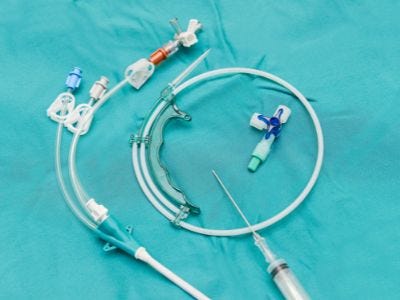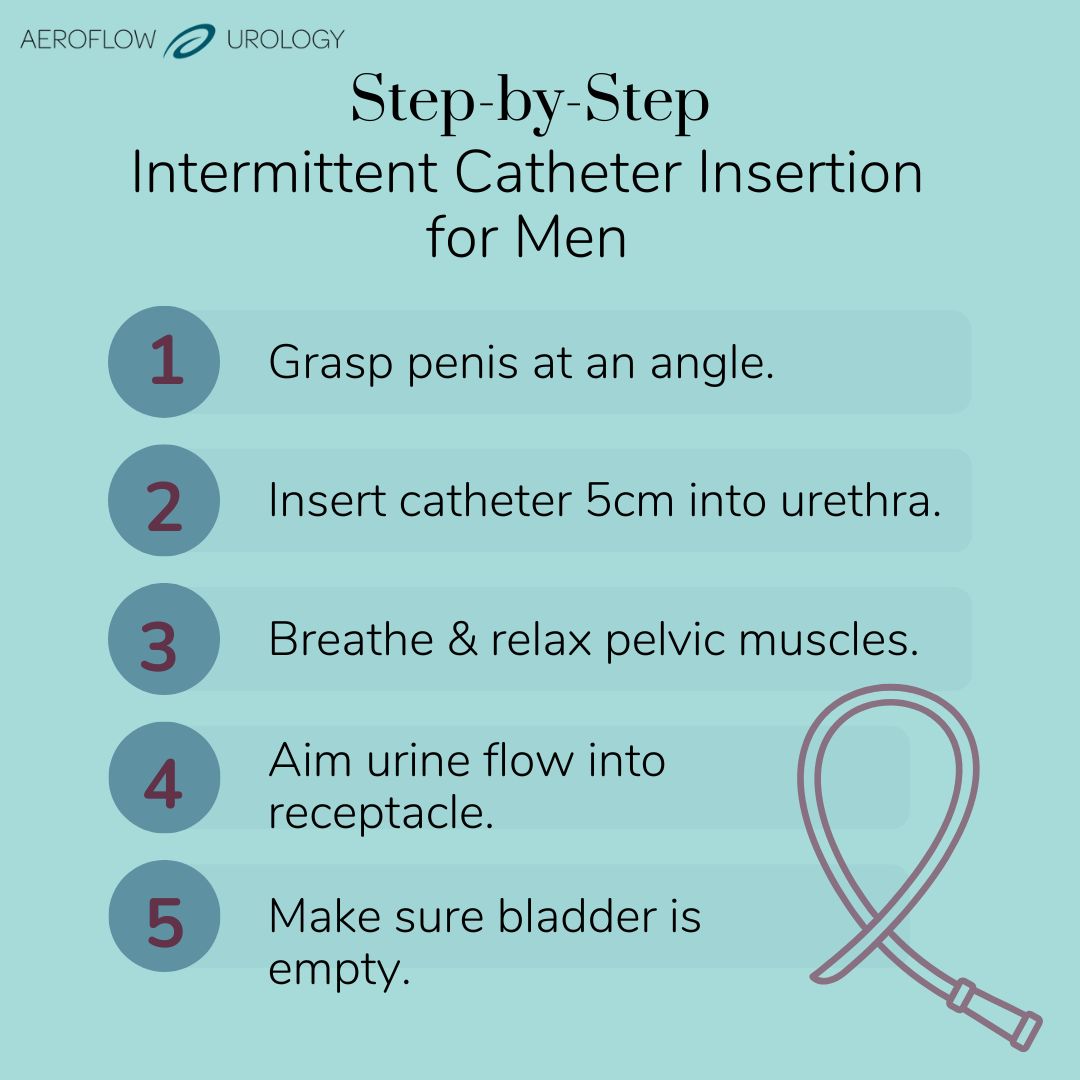This piece has been medically reviewed by Susie Gronski, PT, DPT, Medical Advisor to Aeroflow Urology.
Intermittent catheters are an excellent option for those who need assistance emptying their bladders, but misusing them can increase the risk of developing catheter-associated urinary tract infections (CAUTIs).
This post will tell you what a CAUTI is, what the warning signs of a UTI are, and how to properly use intermittent catheters to decrease your risk of developing catheter-related infections.
What Is a UTI?
A urinary tract infection (UTI) is an infection that occurs within a part of the urinary system, such as the kidneys, bladder, ureters, or urethra.
Usually, your urethra is a sterile environment, but sometimes bacteria can wage an invasion if they get the opportunity.
Check Your Eligibility
2 Easy Steps
Discover the catheter supplies covered by your insurance.
These opportunities typically arise when bacteria are transferred from your external environment to your body.
UTI Symptoms
It is also important to recognize the symptoms of a UTI so treatment can begin immediately. Symptoms of a UTI are:
- Burning with urination.
- Frequent urgency to urinate.
- Cloudy, foul-smelling, or bloody urine.
- Fever or chills.
- Lower abdominal pain or pelvic pressure.
- Burning with urination.
- Frequent urgency to urinate.
What Is a CAUTI?
CAUTI stands for catheter-associated urinary tract infection.


A CAUTI occurs when harmful bacteria enter the urinary system through the urethra while using intermittent catheters. A couple of things can cause this to happen:
- Bacteria from your fecal matter (e. coli) may get on the catheter.
- Your catheter becomes contaminated while inserting it.
- Your catheter is not sanitary.
Intermittent catheter users are at a higher risk of UTIs. In fact, one study examining recurrent UTIs found that over 5 years, 81% of intermittent catheter users had been treated for at least one UTI. Other reports show that out of all UTIs in hospitals, 75% of them are linked to catheter usage, making CAUTI one of the most common infections you can get in a hospital.
While they may seem like just an annoyance, CAUTIs can cause serious health issues if left untreated, such as:
- Internal organ damage.
- Bladder infection.
- Kidney infection.
- Foul-smelling urine.
- Pain or discomfort.
CAUTIs have also been linked to higher death rates, higher healthcare costs, and more extended stays in hospitals.
CAUTI Symptoms
After the bacteria enter your urinary system, they begin to multiply, causing most of the symptoms you experience with a standard UTI. Symptoms include:
- Cloudy urine.
- Bloody urine.
- Bad-smelling urine.
- Leakage around your catheter.
- Pain, pressure, or discomfort in your stomach or lower back.
- Chills or fever.
- Fatigue.
- Nausea or vomiting.
CAUTI & Intermittent Catheters


CAUTI may occur in people who use intermittent catheters due to infections in the bladder lining.
Your bladder lining restores all layers of its lining every 100 days. This is a natural self-protective mechanism to prevent aggressive overgrowth of any one type of bacteria that lives inside the bladder to avoid infections.
It’s suggested that CAUTI infection might be due to a protective covering around bacterial colonies attached to the intermittent catheter and bladder lining. Embedded infections are not permanent but may be more stubborn to work with. Research around biofilms is ongoing.
These microbes will also divide faster and more vigorously with the presence of stress hormones, such as cortisol, because the microbes know the host (your bladder) does not have the defense mechanisms to fight them off.
The level of infection does not correlate with the level of symptoms experienced, so it’s essential for each person using intermittent catheterization to understand the unique signs and symptoms that are most indicative of potential infection for their experience.
Tips for Preventing CAUTI With Intermittent Catheters
Use these at-home remedies to prevent CAUTIs and self-catheterize safely.
1. Practice Good Hygiene
Bacteria is the main enemy of CAUTI, and bacteria are everywhere, even when you can’t see them. Always wash your hands with soap and water before using your intermittent catheter. You should also shower at least once a day and wash your genital area to keep it clean.
2. Learn Proper Insertion & Removal
Unsanitary insertion and removal are one of the main ways bacteria spread from your hands to your urinary system, so make sure you’re following these proper instructions.
You should open your intermittent catheter before handwashing, as the outer package of the catheter is not sterile if it has been stored in a pocket, bag, or purse.


If you have gloves, they can be a great second line of defense if you are catheterizing in public restrooms and are often included in catheter insertion kits.
If you aren’t sure how to safely insert and remove your intermittent catheter, use a downloadable guide.
3. Use Hydrophilic Intermittent Catheters
While every person’s needs are different regarding catheters, intermittent hydrophilic catheters come with sanitary lubrication pre-applied and make insertion easier. You’ll also decrease your chance of spreading bacteria onto your intermittent catheter because you won’t need to apply lubrication yourself.
4. Make an Intermittent Catheter Kit
The right intermittent catheter supplies can ensure easy, sterile catheterization. Catheters should only be opened once before they are ready to be inserted and should never be placed on any surface which is not sterile. A catheter insertion kit can further reduce the risk of a UTI. Most kits include:
- Gloves
- Extra intermittent catheters in case one is dirtied or damaged.
- Sterilizing wipes.
- Lubricant
- Paper towels or other sanitary towels.
5. Stay Regular
If you are constipated, you may have an increased risk of CAUTI. This is because constipation (a full bowel) can interfere with your bladder’s ability to empty fully by applying pressure from the rectum.
If you want to avoid excessive pressure on your bladder, you’ll also want to make regular bowel movements. If you do feel like you could benefit from being more regular, then increase your intake of:
- Fiber
- Fluids
- Probiotic-rich foods, such as yogurt and sauerkraut.
It’s also important to note that drinking cranberry juice or taking cranberry supplements has not been proven to help treat CAUTIs or aid in UTI prevention, so stick with water when hydrating.
6. Reduce Bladder Pressure


It’s important not to put too much pressure on your bladder since an overdistended bladder can contribute to the development of a UTI. That being said, avoiding overfilling your bladder can be a problem if you drink gallons of water daily without emptying your bladder regularly.
7. Self-Catheterize On Schedule
You should change your intermittent catheter more times in a day versus less to prevent your bladder from stretching. Remember that although you want to stay well-hydrated, you also want to ensure you go to the bathroom regularly. If you don’t experience spontaneous voiding, which is the ability to urinate on your own, you’ll need to empty your bladder regularly to ensure it doesn’t become too full.
8. Stay Hydrated
Drinking water flushes the bacteria from your urinary system, so stay hydrated by drinking plenty of water throughout your day.
Get Catheter Products Through Insurance
If you prepare correctly and take a heightened degree of caution, intermittent self-catheterizing does not need to be a source of anxiety. However, UTIs can be a serious health concern, particularly for people that may already be dealing with other severe and concurrent medical issues which may compromise their immune system and resilience.
Another way to reduce the stress of self-catheterization is to get your intermittent catheter supplies paid for through your insurance plan with Aeroflow Urology.
We can supply low-cost catheter products if you qualify and ship them to your doorstep in discreet packaging every month. To see if you’re covered, put your insurance information in our quick Eligibility Form. From there, a catheter expert will reach out to you and help you find the perfect supplies— they’ll even send you free samples before choosing your catheter products.
Wyndaele, J. (2002). Complications of intermittent catheterization: their prevention and treatment. Spinal Cord, 40(10), 536–541. https://doi.org/10.1038/sj.sc.3101348
Centers for Disease Control and Prevention. (2015). Catheter-associated urinary tract infections (CAUTI). Center for Disease Control and Prevention. https://www.cdc.gov/hai/ca_uti/uti.html
Wilks, S. A., Koerfer, V. V., Prieto, J. A., Fader, M., & Keevil, C. W. (2021). Biofilm Development on Urinary Catheters Promotes the Appearance of Viable but Nonculturable Bacteria. MBio, 12(2). https://doi.org/10.1128/mBio.03584-20
Information provided on the Aeroflow Urology blog is not intended as a substitute to medical advice or care. Aeroflow recommends consulting your healthcare provider if you are experiencing medical issues relating to incontinence.








